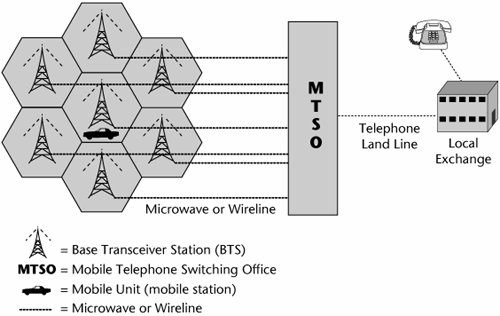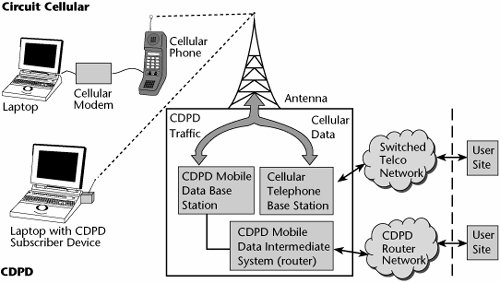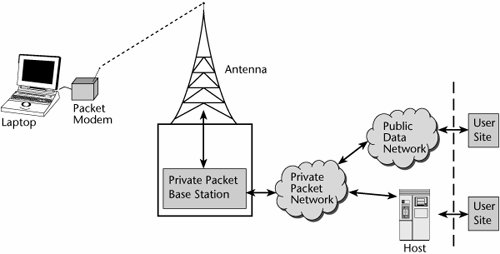1G: Analog Transmission
G Analog Transmission
The first generation of cellular networks consisted of analog transmission systems for both voice and data. Although betterdigitalsystems are now available, it is important to understand the history of WWANs, so the following sections describe 1G systems for voice and data.
1G Analog Cellular Networks
Analog cellular systems have been largely replaced with 2G digital networks, but you're likely to still hear about 1G standards, including the following:
- Advanced Mobile Phone System (AMPS) AMPS, also known as IS-54, is on the 800MHz band, involves some 832 channels per carrier, and originated in the United States.
- Total Access Communication System (TACS) TACS operates in the 900MHz band, offers 1,000 channels, and originated in the United Kingdom.
- Japanese Total Access Communication Systems (JTACS) JTACS works in the 800MHz to 900MHz band, and it comes from Japan.
- Nordic Mobile Telephone (NMT) The original variation of NMT was 450MHz, offering some 220 channels. NMT had a very large coverage area, thanks to its operation at 450MHz (you could probably travel through half of Scandinavia and still be within one cell), but the power levels are so intense that mobile sets were incredibly heavy. NMT originated in Denmark, Finland, Norway, and Sweden.
Other 1G standards used in Europe include Germany and Austria's C-Netz, Sweden's Comvik, NMT-F (France's version of NMT900), and France's Radiocom 2000 (RC2000).
The cellular radio system has three key components (see Figure 14.1): a transceiver station, a mobile telephone switching office (MTSO), and a mobile unit (i.e., the phone). Each cell needs a base transceiver stationa tower that transmits signals to and from the mobile unit. Each of these base transceiver stations connects to an MTSO. The MTSO then interfaces into the terrestrial local exchanges to complete calls over the PSTN. The connections from the base transceiver stations to the MTSO can be either microwave or wireline, and then typically from the MTSO to the local exchange there is a wireline facility, but it could also potentially be microwave. (Chapter 2, "Traditional Transmission Media," discusses the various media options in detail.)
Figure 14.1. The analog cellular architecture

When a mobile unit is on, it emits two numbers consistently: the electronic identification number and the actual phone number of the handset. These are picked up by the base transceiver stations, and depending on the signal level, they can determine whether the unit is well within the cell or transitioning out of that cell. If the unit's power levels start to weaken and it appears that the unit is leaving the cell, an alert is raised that queries the surrounding base transceiver stations to see which one is picking up a strong signal coming in; as the unit crosses the cell perimeter, it is handed over to an adjacent frequency in that incoming cell. The mobile unit cannot stay on the same frequency in between adjacent cells because that would create co-channel interference (i.e., interference between cells).
1G Wireless Data Networks
Early wireless data networking methods included CDPD and packet radio. These technologies are not generally part of new deployments today because better solutions are now available. However, the following sections cover them briefly because you may encounter the language in your studies and should know what it means.
CDPD
CDPD is a packet data protocol designed to work over AMPS or as a protocol for TDMA. The initial concept of CDPD was publicly introduced in 1992. CDPD was envisioned as a wide area mobile data network that could be deployed as an overlay to existing analog systems, a common standard to take advantage of unused bandwidth in the cellular airlink (i.e., the wireless connection between the service provider and the mobile subscriber). (Unused bandwidth is a result of silence in conversations as well as the moments in time when a call is undergoing handover between cells. These periods of no activity can be used to carry data packets and therefore take advantage of the unused bandwidth.) That was the main objective, and it was backed mostly by large cellular network operators.
CDPD is defined as a connectionless, multiprotocol network service that provides peer network wireless extension to the Internet. CDPD's greatest advantage is that it was designed to operate as an extension of existing networks (i.e., IP networks); any application developed for CDPD can be adapted to run on any IP-based network. The complete network specification for CDPDincluding architecture, airlink, network interfaces, encryption, authentication, network management, and securityis defined. Throughput is nominally 19.2Kbps, but 9.6Kbps is more common. CDPD looks like TCP/IP, which gives it some advantages, but it does require a specialized subscriber unit.
Figure 14.2 shows a CDPD network. A mobile user has a CDPD subscriber device, typically a proprietary modem provided by the network operator. Incorporated into the base station are elements such as a CDPD mobile data base station and a CDPD mobile data intermediate system (i.e., a router). The voice calls are switched out over the telco network, and the data traffic is sent over the CDPD router network.
Figure 14.2. The CDPD network architecture

Packet Radio
Packet radio data networks are an offshoot of Specialized Mobile Radio (SMR). They use licensed bandwidth and are built specifically for two-way data, not for voice communications. The data rates supported by packet radio range up to 19.2Kbps, but the norm is 9600bps. The best applications for packet radio include sessions that are short, as in Short Messaging Service (SMS), transaction processing, and, in some cases, e-mail; packet radio is not a solution for bulk file transfers or client/server interactions. The key applications for packet radio include dispatching, order processing, airline reservations, financial services and banking, lottery, remote database access, messaging, point-of-sale, and telemetry.
In the packet radio data network configuration shown in Figure 14.3, the end user has a mobile unit, a laptop, and a proprietary packet modem that provides access to the private packet base station. A private packet network is the backbone, and it may interface into public data networks or be used on a private basis, for a company's own enterprise network.
Figure 14.3. Packet radio data network architecture

Among the packet data options is Mobitex, a paging network developed by Ericsson (www.ericsson.com). It is an open standard for dedicated wireless data and emphasizes reliability and its use in safety-type applications. It is therefore mainly used by military, police, firefighters, and ambulance services. Around 150 such organizations use Mobitex, which offers a highly reliable communications channel for data where communication must never fail. Mobitex is a trunked radio system based on X.25, originally operating at 8Kbps and now ranging up to 19.2Kbps, and it is built using a fault-tolerant architecture. It is a packet-switched, narrowband, data-only technology mainly for short-burst data. It is ideally suited for applications such as interactive messaging, e-mail, machine-to-machine, telematics/positioning, and forms-based applications. Mobitex channels are 12.5KHz wide. All Mobitex networks operate in one of five frequency families: 80MHz, 160MHz, 400MHz (generally between 415MHz and 430 MHz), 800MHz (generally between 820MHz and 870MHz), or 900MHz (generally between 895MHz and 910 MHz). Frequencies and channels are generally assigned by national government authorities.
Mobitex is offered on more than 30 networks on five continents, but by 2005 it was used primarily in the United States and Canada. European Mobitex networks withered in the face of the overwhelming success of GSM. However, now in its fifth major revision, Mobitex continues to be improved and enhanced for demanding professional use, and the Mobitex Association (www.mobitex.org) reported that its 2005 conference was a great success. The Mobitex system equipment, terminal equipment, and network architecture are continually being enhanced to meet and adapt to changing market needs. The detailed product roadmap extends five years into the future and includes a number of important hardware and software development projects that will result in improved performance, decreased investment, and cost-efficient operations for Mobitex operators. Mobitex is also being used in combination with GPRS, WLAN (802.11), satellite, and CDMA, and we are seeing new products such as dual-mode modems, gateway products, and software that support this development. There are also several new Bluetooth-enabled products and applications for Mobitex.
G Digital Cellular Radio |
Part I: Communications Fundamentals
Telecommunications Technology Fundamentals
- Telecommunications Technology Fundamentals
- Transmission Lines
- Types of Network Connections
- The Electromagnetic Spectrum and Bandwidth
- Analog and Digital Transmission
- Multiplexing
- Political and Regulatory Forces in Telecommunications
Traditional Transmission Media
Establishing Communications Channels
- Establishing Communications Channels
- Establishing Connections: Networking Modes and Switching Modes
- The PSTN Versus the Internet
The PSTN
- The PSTN
- The PSTN Infrastructure
- The Transport Network Infrastructure
- Signaling Systems
- Intelligent Networks
- SS7 and Next-Generation Networks
Part II: Data Networking and the Internet
Data Communications Basics
- Data Communications Basics
- The Evolution of Data Communications
- Data Flow
- The OSI Reference Model and the TCP/IP Reference Model
Local Area Networking
Wide Area Networking
The Internet and IP Infrastructures
- The Internet and IP Infrastructures
- Internet Basics
- Internet Addressing and Address Resolution
- The Organization of the Internet
- IP QoS
- Whats Next on the Internet
Part III: The New Generation of Networks
IP Services
Next-Generation Networks
- Next-Generation Networks
- The Broadband Evolution
- Multimedia Networking Requirements
- The Broadband Infrastructure
- Next-Generation Networks and Convergence
- The Next-Generation Network Infrastructure
Optical Networking
- Optical Networking
- Optical Networking Today and Tomorrow
- End-to-End Optical Networking
- The Optical Edge
- The Optical Core: Overlay Versus Peer-to-Peer Networking Models
- The IP+Optical Control Plane
- The Migration to Optical Networking
Broadband Access Alternatives
- Broadband Access Alternatives
- Drivers of Broadband Access
- DSL Technology
- Cable TV Networks
- Fiber Solutions
- Wireless Broadband
- Broadband PLT
- HANs
Part IV: Wireless Communications
Wireless Communications Basics
- Wireless Communications Basics
- A Brief History of Wireless Telecommunications
- Wireless Communications Regulations Issues
- Wireless Impairments
- Antennas
- Wireless Bandwidth
- Wireless Signal Modulation
- Spectrum Utilization
Wireless WANs
- Wireless WANs
- 1G: Analog Transmission
- 2G: Digital Cellular Radio
- 5G: Enhanced Data Services
- 3G: Moving Toward Broadband Wireless
- Beyond 3G
- 4G: Wireless Broadband
- 5G: Intelligent Technologies
WMANs, WLANs, and WPANs
Emerging Wireless Applications
- Emerging Wireless Applications
- The Handset Revolution
- Mobile IP
- The IP Multimedia Subsystem
- Mobile Gaming
- Mobile Video
- Mobile TV
- Mobile Content
Glossary
EAN: 2147483647
Pages: 160
